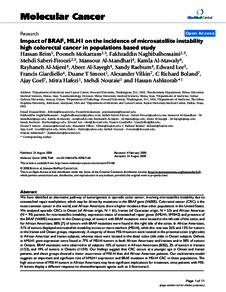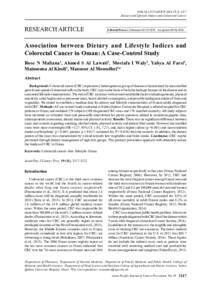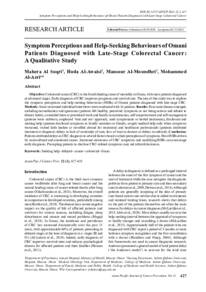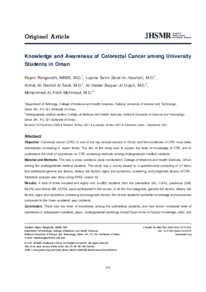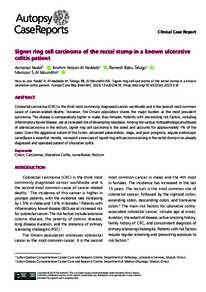Document
Impact of braf, mlh1 on the incidence of microsatellite instability high colorectal cancer in populations based study.
Identifier
DOI: 10.1186/1476-4598-7-68
Contributors
Mokarram, Pooneh., Author
Naghibalhossaini, Fakhraddin., Author
Saberi-Firoozi, Mehdi., Author
Al-Mandhari, Mansour., Author
Al-Mawalyah, Kamla., Author
Al-Sayegh, Abeer., Author
Raeburn, Sandy., Author
Lee, Edward., Author
Giardiello, Francis., Author
Smoot, Duane T., Author
Vilkin, Alexander., Author
Boland, C Richard., Author
Goel, Ajay., Author
Hafezi, Mitra., Author
Nouraie, Mehdi., Author
Ashktorab, Hassan., Author
Al-Mjeniyah, Rayhaneh., Author
Publisher
BioMed Central.
Gregorian
2008-09
Language
English
Subject
English abstract
We have identified an alternative pathway of tumorigenesis in sporadic colon cancer, involving microsatellite instability due to mismatched repair methylation, which may be driven by mutations in the BRAF gene (V600E). Colorectal cancer (CRC) is the most common cancer in the world, and African Americans show a higher incidence than other populations in the United States. We analyzed sporadic CRCs in Omani (of African origin, N = 61), Iranian (of Caucasian origin, N = 53) and African American (N = 95) patients for microsatellite instability, expression status of mismatched repair genes (hMLH1, hMSH2) and presence of the BRAF (V600E) mutation. In the Omani group, all tumors with BRAF mutations were located in the left side of the colon, and for African Americans, 88% 7 of tumors with BRAF mutations were found in the right side of the colon. In African Americans, 31% of tumors displayed microsatellite instability at two or more markers (MSI-H), while this rate was 26% and 13% for tumors in the Iranian and Omani groups, respectively. A majority of these MSI-H tumors were located in the proximal colon (right side) in African American and Iranian subjects, whereas most were located in the distal colon (left side) in Omani subjects. Defects in hMLH1 gene expression were found in 77% of MSI-H tumors in both African Americans and Iranians and in 38% of tumors in Omanis. BRAF mutations were observed in all subjects: 10% of tumors in African Americans (8/82), 2% of tumors in Iranians (1/53), and 19% of tumors in Omanis (11/59). Our findings suggest that CRC occurs at a younger age in Omani and Iranian patients, and these groups showed a lower occurrence of MSI-H than did African American patients. Our multivariate model suggests an important and significant role of hMLH1 expression and BRAF mutation in MSI-H CRC in these populations. The high occurrence of MSI-H tumors in African Americans may have significant implications for treatment, since patients with MSI-H lesions display a different response to chemotherapeutic agents such as 5-fluorouracil.
Member of
ISSN
1476-4598
Resource URL
Category
Journal articles

